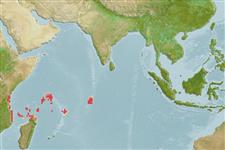Common names from other countries
>
Ovalentaria/misc (Various families in series Ovalentaria) >
Pseudochromidae (Dottybacks) > Anisochrominae
Etymology: Anisochromis: Greek, anisos = unequal + Greek, chromis = a marine fish without identification, dealing with perch; cited by Plinius (Ref. 45335).
More on author: Smith.
Environment: milieu / climate zone / depth range / distribution range
Ökologie
seewasser riff-verbunden; tiefenbereich 0 - 9 m (Ref. 42958). Tropical; 3°S - 15°S
Western Indian Ocean: East Africa, Comoros and northern Madagascar.
Size / Gewicht / Alter
Maturity: Lm ? range ? - ? cm
Max length : 3.1 cm TL Männchen/unbestimmt; (Ref. 5471)
Kurzbeschreibung
Morphologie | Morphometrie
Rückenflossenstacheln (insgesamt): 1; Rückenflossenweichstrahlen (insgesamt): 25-26; Afterflossenstacheln 1; Afterflossenweichstrahlen: 17 - 18. Caudal vertebrae, 22-24 (usually 23). Lateral line scales usually 38-41. Anterior lateral line scales 28-35, usually 30-34.
Inhabits reefs and pools exposed at low tide. A protogynous hermaphrodite. Difficult to catch because of its small size.
Life cycle and mating behavior
Geschlechtsreife | Fortpflanzung | Ablaichen | Eier | Fecundity | Larven
Gill, A.C. and R. Fricke, 2001. Revision of the Western Indian ocean fish subfamily Anisochrominae (Perciformes, Pseudochromidae). Bull. Nat. Hist. Mus. Lond. (Zool.) 67(2):191-207. (Ref. 42958)
IUCN Rote Liste Status (Ref. 130435)
CITES (Ref. 128078)
Not Evaluated
Bedrohung für Menschen
Harmless
Nutzung durch Menschen
Mehr Information
NamenSynonymeMetabolismusRäuberÖkotoxikologieFortpflanzungGeschlechtsreifeAblaichenFecundityEierEientwicklung
Alter/GrößeWachstumLänge-GewichtLänge-LängeLängenhäufigkeitenMorphometrieMorphologieLarvenLarven Pop.Dyn.RekrutierungDichte
ReferenzenAquakulturAquakultur ProfilZuchtlinienGenetikElectrophoresesVererbbarkeitKrankheitenVerarbeitungMass conversion
PartnerBilderStamps, Coins Misc.LauteCiguateraGeschwindigkeitSchwimmstilKiemenoberflächeOtolithsGehirngrößeSehfähigkeit
Tools
Zusatzinformationen
Download XML
Internet Quellen
Estimates based on models
Preferred temperature (Ref.
115969): 27.1 - 28.4, mean 27.5 (based on 146 cells).
Phylogenetic diversity index (Ref.
82804): PD
50 = 0.6250 [Uniqueness, from 0.5 = low to 2.0 = high].
Bayesian length-weight: a=0.00389 (0.00180 - 0.00842), b=3.12 (2.94 - 3.30), in cm Total Length, based on all LWR estimates for this body shape (Ref.
93245).
Trophic level (Ref.
69278): 3.7 ±0.59 se; based on food items.
Fishing Vulnerability (Ref.
59153): Low vulnerability (10 of 100).
